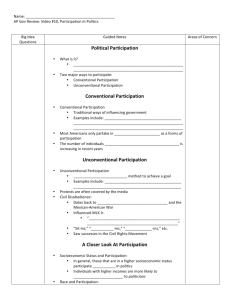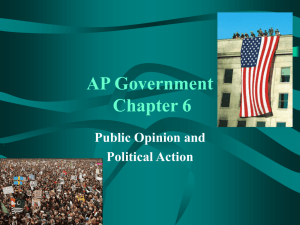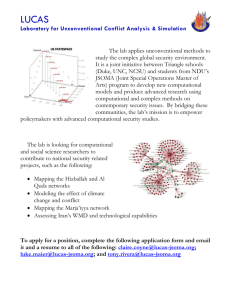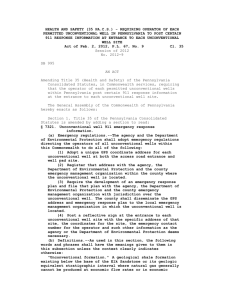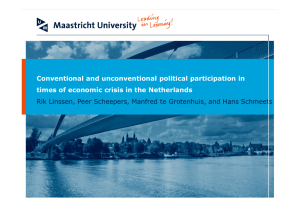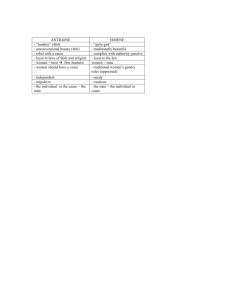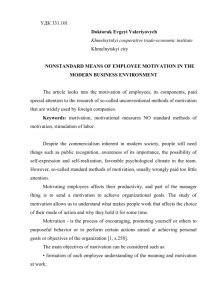Psychological Impact and Risk Communication
advertisement
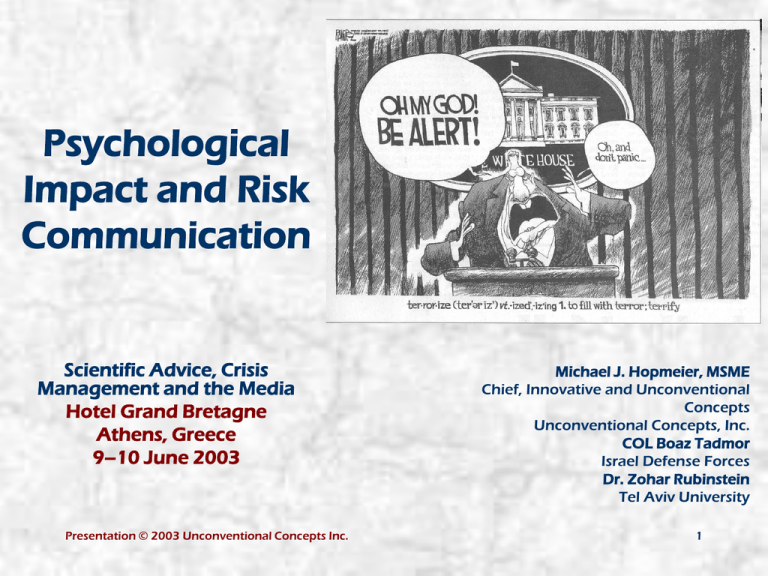
Psychological Impact and Risk Communication Scientific Advice, Crisis Management and the Media Hotel Grand Bretagne Athens, Greece 9–10 June 2003 Presentation © 2003 Unconventional Concepts Inc. Michael J. Hopmeier, MSME Chief, Innovative and Unconventional Concepts Unconventional Concepts, Inc. COL Boaz Tadmor Israel Defense Forces Dr. Zohar Rubinstein Tel Aviv University 1 September 11, 2001 World Trade Centers Towers 1 and 2 New York City Presentation © 2003 Unconventional Concepts Inc. 2 Suicide Bombings Presentation © 2003 Unconventional Concepts Inc. 3 Psychological Definitions of Crisis/ Disaster Situations An external situation which presents a threat to a person or his/her relatives, interrupts the functional, cognitive and historical continuance amongst individuals, families, groups and the community. —Home Front Command Israel Defense Forces Presentation © 2003 Unconventional Concepts Inc. 4 Psychological Trauma and Communication: Brief Overview Orson Wells’ 1938 radio broadcast “War of the Worlds” resulted in pandemonium and paranoia Coverage of recent terrorist events reveals that the media must strike a balance between informing the public and not contributing to psychological trauma Presentation © 2003 Unconventional Concepts Inc. 5 PTSD and the Effects of Traumatic TV Images Study by Ahern et al. (2002) found that people who were directly affected by the 9/11 terrorist attacks and who viewed disturbing TV images >7 times were 7 times more likely to develop PTSD The same study found that 3.6% who were not directly affected by the attacks still developed PTSD from repeatedly watching disturbing TV images Previous studies with children with direct involvement in the Oklahoma City bombing and Gulf War suggest a causal link between PTSD and watching violent images of events on TV Presentation © 2003 Unconventional Concepts Inc. 6 The Public Wants to “Do Something” Although duct tape defense provides minimal physical protection, there is something to be said for the sense of psychological comfort created by having “done something” to prepare for a potential attack However, a recent Harvard study found that 73% were aware of the posted high alert level (orange) but only 12% had developed an evacuation plan Presentation © 2003 Unconventional Concepts Inc. 7 Presentation © 2003 Unconventional Concepts Inc. 8 Before the 2003 Iraq War Israel Defense Forces Distributed protective kits (including gas masks) to the entire Israeli population Informed the public how to create protected and sealed spaces in dwellings Created an efficient medicine distribution system and a nationwide alarm system Home Front Command Launched an information campaign to educate the public on what to expect and how to cope Presentation © 2003 Unconventional Concepts Inc. 9 Israeli Public Response In spite of everything, as recently as 1 week before the outbreak of hostilities, compliance with safety directives was as low as 60% The psychological impact of seeing the war progress and the nation’s emotional response (as measured by numerous polls) correlated almost perfectly Presentation © 2003 Unconventional Concepts Inc. 10 Communication and Psychological Impact There is unquestionably a link Over 2,000 studies in the past 30 years on children and exposure to TV violence find an increase in aggressive behavior The long-term negative psychological effects of the media and disasters can be mitigated, but only with proper preparation Presentation © 2003 Unconventional Concepts Inc. 11 Mitigation Anticipate what the audience wants to hear to allay fears Hurricane George in Puerto Rico in 1998 was an example of excellent communication with a constant flow of updated, accurate information Communication clearly addressed the audience’s main concern: the hurricane’s impact on tourism, one of the island’s main industries Presentation © 2003 Unconventional Concepts Inc. 12 Presentation © 2003 Unconventional Concepts Inc. 13 Presentation © 2003 Unconventional Concepts Inc. 14 New York Times, October 28, 2001 Presentation © 2003 Unconventional Concepts Inc. 15 Anthrax Scare Negative psychological effects—fear and paranoia—are more damaging than anthrax In April 1997, 17 employees at the B'nai Brith National Headquarters went to D.C.- area hospitals after feeling ill—tests later proved the substance they encountered was not anthrax In fall 2001, 35 people in a Maryland subway reported nausea, sore throat, and headache after exposure to hoax “liquid anthrax” —window-cleaning fluid “But in my opinion we need to protect the Americans not from anthrax, but from the feeling of fear... I'm serious... Panic is even worse than the disease." —Benjamin Cherkassky, a senior scientist at Moscow's Central Institute of Epidemiology Presentation © 2003 Unconventional Concepts Inc. 16 Anthrax Scare—Lessons Learned Decisions had to be made rapidly in the absence of data Access to subject matter experts was limited No “textbook” experience to guide a response Understanding of “risk” evolved as outbreak unfolded Exaggerated or ambiguous risk assessment creates elevated fear and establishes a sense of distrust among the public for future warnings Advising the public not to panic induces the opposite response Need a coherent, rapid process for addressing scientific issues in the midst of a crisis Presentation © 2003 Unconventional Concepts Inc. 17 Communication It is both information and education! It works both ways: to and from leadership The principal source of intelligence and realtime planning information is the media! The public depends on the media to provide background and guidance on how to react It is vital both before and after an incident It prepares the public so they understand what is happening It gives them instruction on how to respond to what is happening Presentation © 2003 Unconventional Concepts Inc. 18 “Principles for Intervention amongst Disaster Stricken Population” “’Help them help themselves’—Create a feeling of competence “Create minimal dependence on formal and external assistance “Channel the negative responses to positive action “What appears as panic stricken civilians is nothing other than unorganized activity, which can be organized” —Home Front Command Israel Defense Forces Presentation © 2003 Unconventional Concepts Inc. 19 “Principles for Intervention amongst Disaster Stricken Population” “Prevent or minimize secondary gains “Utilize the population as a resource “Secure initial success in order to build trust in the community and authorities “Support the community with ongoing information “What works in routine should work in an emergency” —Home Front Command Israel Defense Forces Presentation © 2003 Unconventional Concepts Inc. 20 Summary “Mob psychology” is the ruling factor We do not have enough resources to provide for the public independently, so we must involve the public in its own protection To do this, the members of the public must know how to protect themselves and be confident that they can Using the media to educate people and quell their fears is the only practical way this can be done Media should be considered on par with fire, police, and emergency medical personnel The media can be your enemy if you work with them-they will be if you don’t! Presentation © 2003 Unconventional Concepts Inc. 21 And Finally... We must all hang together or, most assuredly, we shall surely hang separately! —Benjamin Franklin Presentation © 2003 Unconventional Concepts Inc. 22
